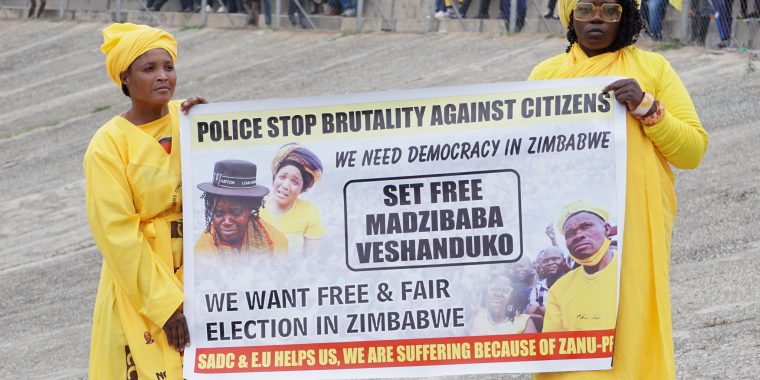Precious
Dinha,
left,
holds
a
banner
at
a
rally
in
Mutare,
Zimbabwe,
on
March
19,
2022,
for
opposition
presidential
candidate
Nelson
Chamisa.
Photo
Credit:
Evidence
Chenjerai,
Global
Press
Journal
Zimbabwe
Evidence
Chenjerai,
Global
Press
Journal
Zimbabwe
This
story
was
originally
published
by
Global
Press
Journal.
MUTARE,
ZIMBABWE
—
Precious
Dinha
elbows
her
way
into
a
packed
soccer
stadium.
Despite
thunderclouds
looming
above,
thousands
of
yellow-clad
Zimbabweans
are
singing,
dancing
and
thrusting
their
index
fingers
skyward.
They
wave
placards
in
Shona
and
English
saying,
“We
need
democracy
in
Zimbabwe”
and
“Police
stop
brutality
against
citizens.”
Dinha
unfurls
her
own
large
white
banner:
“We
want
free
and
fair
elections.”
Soon
Zimbabwe’s
leading
opposition
presidential
candidate,
44-year-old
Nelson
Chamisa,
bounds
onto
a
stage.
“Do
you
embrace
the
new?”
he
asks.
“Yes!”
the
crowd
shouts.
Dinha
traveled
close
to
four
hours
from
Harare,
the
capital,
to
hear
Chamisa
speak.
She
attends
every
Chamisa
rally
she
can,
wearing
yellow,
the
color
of
his
movement,
and
reveling
in
the
festive
atmosphere.
This
event
marks
the
formal
introduction
of
his
new
political
party,
Citizens
Coalition
for
Change
(CCC),
in
eastern
Zimbabwe
ahead
of
next
year’s
presidential
election.
Dinha,
32,
believes
Chamisa’s
relative
youth
and
outsider
perspective
can
help
resuscitate
Zimbabwe’s
listless
economy,
with
high
levels
of
unemployment,
inflation
and
food
insecurity.
“I
have
never
been
employed
despite
having
professional
qualifications.
I
do
not
even
know
what
a
pay
slip
looks
like,”
Dinha
says.
She
was
trained
as
a
human
resources
manager
but
raises
chickens
and
sells
secondhand
clothes
to
get
by.
“He
understands
us
as
youths,
and
there
are
promises
of
reviving
the
economy
so
that
we
can
also
have
jobs.”
Despite
his
supporters’
fervency,
Chamisa
faces
a
tough
road
to
the
presidency.
In
2018,
he
lost
a
bid
to
wrest
control
from
the
Zimbabwe
African
National
Union-Patriotic
Front
(ZANU-PF),
the
ruling
party
since
1980,
in
an
election
whose
fairness
an
international
election
monitoring
team
questioned.
But
in
the
years
since,
other
southern
African
opposition
leaders
have
found
success
in
copying
the
Chamisa
playbook:
targeting
young,
social
media-savvy
voters
fed
up
with
entrenched
parties
and
alleged
corruption.
Chamisa
supporters
believe
recent
upstart
victories
in
Malawi
and
Zambia
could
foreshadow
his
own.
“2022
is
the
year
when
change
in
Zimbabwe
was
authored
by
God,”
he
tells
the
rally
crowd.
“No
one
can
stop
an
idea
whose
time
has
come.”
With
little
public
polling
in
Zimbabwe,
it’s
hard
to
assess
his
chances.
Mike
Bimha,
ZANU-PF’s
secretary
for
commissariat,
dismisses
Chamisa
as
an
electoral
threat.
“It
is
still
an
opposition
which
came
out
of
forces
from
outside
Zimbabwe
who
want
a
regime
change,”
Bimha
says.
Chamisa
stumbled
into
the
political
spotlight.
In
2018,
Zimbabweans
had
just
witnessed
the
ouster
of
their
longtime
leader,
Robert
Mugabe,
in
a
military
coup.
As
the
new
president,
Emmerson
Mnangagwa
vowed
to
modernize
the
health
care
system,
repair
crumbling
infrastructure
and
rebuild
frayed
business
ties
with
Europe.
He
expected
to
face
the
popular
opposition
candidate
Morgan
Tsvangirai
in
that
July’s
presidential
election,
but
just
months
before
the
vote,
Tsvangirai
died
of
complications
related
to
cancer.
Chamisa
stepped
in.
A
former
student
activist
and
member
of
Parliament,
Chamisa
found
ways
to
sidestep
government-controlled
media
outlets
and
drum
up
support.
He
electrified
crowds
around
the
country
with
rallies
that
enhanced
his
name
recognition
and
built
community
among
his
backers,
and
wooed
voters
directly
on
social
media.
(He
now
has
1
million
Twitter
followers.)
Nevertheless,
Zimbabwe’s
first
post-Mugabe
election
ended
in
turmoil,
with
vote-rigging
allegations
and
protests
where
security
forces
fired
into
crowds
and
several
people
died.
The
Zimbabwe
Electoral
Commission
—
long
criticized
by
opposition
parties
as
an
arm
of
ZANU-PF
—
eventually
declared
Mnangagwa
the
winner
with
50.8%
of
the
vote.
Afterward,
the
Zimbabwe
International
Election
Observation
Mission,
a
group
of
international
election
observers,
denounced
the
process,
saying
Zimbabwe
lacked
“a
tolerant,
democratic
culture”
where
“parties
are
treated
equitably
and
citizens
can
cast
their
vote
freely.”
A
Zimbabwe
Electoral
Commission
spokesperson
didn’t
respond
to
requests
for
comment.
Bimha,
the
ZANU-PF
official,
says,
“We
want
free
and
fair
elections,
harmony,
love
and
collaboration,
and
that
is
a
party
position.”
Elsewhere
in
the
region,
many
voters
shared
the
frustrations
of
Chamisa
supporters,
says
political
analyst
Onai
Moyo,
believing
that
the
leaders
who
freed
their
countries
from
colonialism
had
subsequently
failed
at
governing.
In
2020,
Lazarus
Chakwera
won
the
presidency
in
Malawi.
In
2021,
Hakainde
Hichilema
clinched
victory
in
Zambia.
Both
opposition
candidates
rallied
voters
with
a
Chamisa-esque
message
of
African
renaissance.
Their
argument:
The
ruling
class
had
fallen
prey
to
corruption,
leaving
the
continent
poor
and
underdeveloped
despite
its
vast
natural
resources.
In
Zimbabwe,
that
message
has
gained
traction
even
with
older
voters.
Cresencia
Chabuka,
61,
was
a
senator
with
Chamisa’s
old
political
coalition,
the
Movement
for
Democratic
Change
Alliance.
She
joined
Chamisa’s
new
party,
she
says,
because
pensioners
like
her
are
suffering
from
poverty
as
hyperinflation
erodes
their
savings.
At
the
soccer
stadium
rally,
she
flits
through
the
crowd,
trying
to
convince
her
peers
that
Chamisa
is
the
solution.
“A
lot
of
senior
citizens
have
lost
faith
in
ZANU
promises,”
she
says.
Even
so,
there
are
key
differences
between
Zimbabwe
and
its
neighbors.
For
example,
since
liberation
in
the
1960s,
Zambians
have
chosen
four
different
political
parties
to
run
the
country.
Each
ruled
for
many
years,
but
the
periodic
change
in
leadership
meant
Zambia’s
election
system
wasn’t
intertwined
with
a
single
party,
Moyo
says.
In
Zimbabwe,
one
party
—
and
mainly
one
man
—
was
in
charge.
ZANU-PF
was
instrumental
in
overthrowing
white-minority
rule
in
the
1970s,
a
campaign
that
was
bloodier
than
in
either
Zambia
or
Malawi.
“Zimbabwe’s
independence
came
through
a
liberation
struggle,”
says
political
analyst
Alexander
Rusero.
“It
came
at
the
bedrock
of
massive
violence
of
several
forms,
coupled
with
inflicting
pain
and
fear
in
the
masses.”
To
party
loyalists,
ZANU-PF
has
earned
the
right
to
lead
Zimbabwe.
“Nyika
inotongwa
nevene
vayo,”
they
say
in
Shona
—
only
the
liberators
can
rule.
Even
voters
fed
up
with
the
ruling
class
may
not
rally
for
Chamisa.
Tendai,
47,
who
asked
to
be
identified
only
by
his
first
name
because
of
Zimbabwe’s
history
of
political
violence,
lives
in
Mutare
and
scrapes
by
on
gardening
jobs.
He
voted
for
ZANU-PF
in
2018,
hoping
for
an
economic
revival
that
never
arrived.
While
he’s
lost
faith
in
Mnangagwa,
he
doesn’t
view
Chamisa
as
a
viable
alternative.
“Once
you
vote
them
into
power,
they
serve
self-interests
and
forget
us,”
Tendai
says.
He
plans
to
stay
home
instead
of
voting.
This
March,
Zimbabwe
held
elections
for
various
parliamentary
and
council
seats.
They
did
not
bode
well
for
Chamisa’s
party.
Before
the
vote,
Vice
President
Constantino
Chiwenga
vowed
that
ZANU-PF
would
defeat
CCC
—
something
he
compared
to
crushing
lice.
The
next
day,
a
Chamisa
supporter
was
fatally
stabbed
at
a
rally.
Though
Chamisa’s
party
won
a
majority
of
contested
seats,
most
were
already
in
the
hands
of
opposition
candidates;
ZANU-PF
even
recovered
two
seats
it
had
lost
in
previous
contests.
Chamisa
often
promises
electoral
reforms
in
his
speeches,
but
his
allies
don’t
have
the
numbers
in
Parliament
to
make
changes
before
the
next
election.
“We
are
likely
to
have
history
repeating
itself
when
it
comes
to
violence,”
Rusero
says.
“I
also
don’t
see
the
elections
bringing
the
much-needed
change,
instead
worsening
the
situation
and
deepening
the
divide
that
exists
among
Zimbabweans.”
At
the
soccer
stadium
rally,
Dinha
is
more
optimistic.
A
devout
Christian,
she
sees
Chamisa
as
a
Moses-like
figure,
tasked
with
leading
Zimbabwe
to
a
political
promised
land.
All
around
her,
supporters
sweat
out
the
three-hour
rally;
some
had
climbed
trees
outside
the
stadium
to
get
a
better
glimpse
of
the
candidate.
Others
raise
placards
saying,
“ngaapinde
hake
mukomana”
—
let
the
boy
rule.
Evidence
Chenjerai
is
a
Global
Press
Journal
reporter
based
in
Mutare,
Zimbabwe.
Post
published
in:
Featured
 Chris
Chris













 Kathryn
Kathryn
